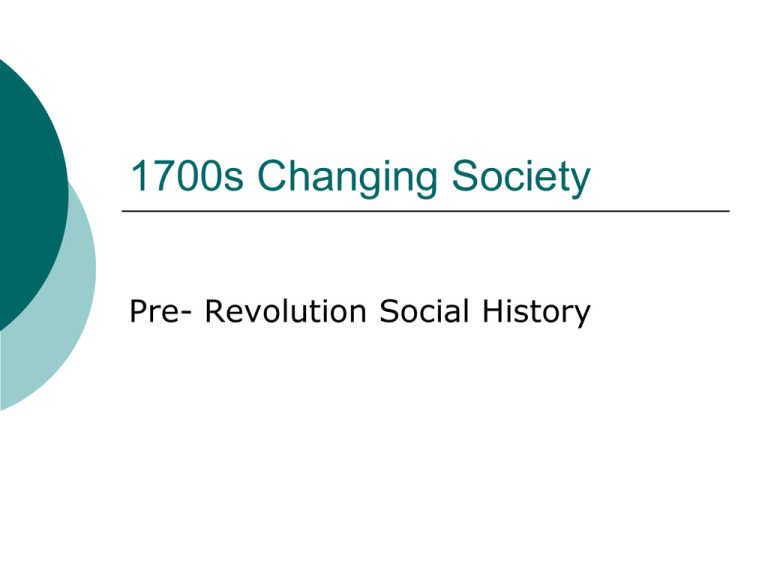1700s Changing Society Pre- Revolution Social History
advertisement

1700s Changing Society Pre- Revolution Social History Marriage and the Family Extended versus nuclear family 27 yrs old average age for marriage Reasons for late marriage– economic/land and dowry; legal permission by local lord and/or village elders Helped maintain balance between # of people and economic resources Lower class youth apprentices Boys- apprenticed 7-14 years to learn a trade Could not marry; paid little /worked hard Goal- admitted to guild= economic independence Most often- drift/odd jobs/ lack of employment stability Lower class youth apprentices pt.2 Young girls- sent into “service” –often upper class households Salaries paid directly to family Often mistreated/overworked; subjected to sexual exploitation Girls with little recourse as servantsLed to pregnancy and increased prostitution in London and Paris as source of income to survive. Social Patterns of Sex, Marriage and Illegitimate Children Pre- 1750- late marriages, premarital sex common but illegitimate births rare. Community controls effective in social responsibility Cottage industry and movement for employment begins to break down this system. Social Patterns of Sex, Marriage and Illegitimate Children- pt 2 1750-1850- illegitimacy explosion Cottage industry redefines village controls- more movement for employment, marriage earlier, love matches, less village pressure to turn “pregnancy into marriage” Unstable trends would last into the late 1800’s. Children and Education High infant mortality rate High illiteracy rate among both boys and girls Most advantages to upper class Wet nursing use common in upper class families- often the wet nurse blamed for infant deaths/ bad temperment Children and Education Infanticide not condoned but suggested for unwanted babies(girls) Overlaying another technique Foundling homes accepted babies no questions asked Were often over loaded and poorly staffed – 50% babies died. Children and Education Parental indifference toward children- little emotional investment Harsh discipline Rousseau leads change in attitude Education of upper class increases Private schools/tutors only Enlightenment has little impact on peasant/worker education Food and Medical practices Grain-- the staple of life Dark bread versus white bread Just price- “fair” /government controlled Adam Smith/supply and demand stops just price– creating crises, hoarding, even “revolutions” Food and Medical practices Upper class- poor diets: white breads, sugar, meats, overdrinking, organ meats= gout Middle class-more lower class; could afford “some” upper class food Lower class- best diet- fruits, vegetables, less meat, dark bread, All classes dealt with scurvy- A&C def. Food and Medical practices Potatoes became a staple for the desperately poor of Ireland and spread slowly through Europe Sugar went down in price due to slave triangle- led to tooth decay Food and Medical practices Faith healers, apothecaries, physicians, surgeons and midwives Faith healers- based on good and evil demons and prayer Apothecaries- herbs, drugs, and patent medicines- also blood letting Physicians- mostly men– on the job training mostly in hospitals Food and Medical practices Surgeons- made significant progress (at patient expense)- most on the job training after battlessawing off limbs and cauterize major wounds- no painkillers or aeneseptic Midwives- trained by other midwives- treated with suspicion; with invention of forceps physicians began to undermind confidence in midwifery Hospitals and medical experiments DON”T GO THERE!!! Filthy, dirty, die from infection Bright spot- Phillip Pinel – humanized treatment of mentally ill in Paris Edward Jenner- smallpox vaccination- through Baconian process – associated cow pox to small pox to create vaccination Religion and Popular Culture Jesuits- increase in state power versus papal weakness; when Jesuits tried to influence political matters, often expelled - Louis XV Protestant Revival- called Pietism 1) warm emotional religion 2)stress priesthood of believers 3) Reborn Christian must lead good moral lives Influenced John Wesley- methodists Religion and Popular Culture Carnival- time of reveling and excess Catholic and med Europe (still Brazil) Preceded Lent Excessive rowdiness, turned established order upside down Protestants more stoic- not as willing to participate Some used Carnival to teach an enemy a lesson




